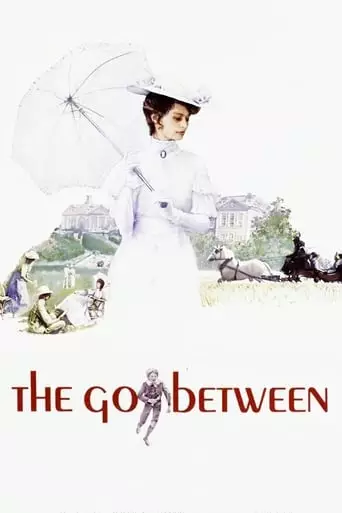British teenager Leo Colston spends a summer in the countryside, where he develops a crush on the beautiful young aristocrat Marian. Eager to impress her, Leo becomes the go-between for Marian, delivering secret romantic letters to Ted Burgess, a handsome neighboring farmer.
The Go-Between is a 1971 British film directed by Joseph Losey, adapted from L.P. Hartley’s novel. Set in 1900, the story follows twelve-year-old Leo Colston (Dominic Guard), who spends his summer at Brandham Hall, the Norfolk estate of his wealthy school friend, Marcus Maudsley (Richard Gibson). Leo feels out of place among the upper class but is welcomed by Marcus’s sister, Marian (Julie Christie), who dotes on him and buys him new clothes.
When Marcus falls ill, Leo is left to entertain himself. He meets tenant farmer Ted Burgess (Alan Bates), who asks Leo to deliver a letter to Marian. Unbeknownst to Leo, Ted and Marian are engaged in a clandestine affair, and Leo becomes their unwitting messenger. As Leo delivers more letters between the lovers, he remains innocent about their true nature.
Marian is expected to marry Hugh, Viscount Trimingham (Edward Fox), as arranged by her parents. Despite this, she continues her affair with Ted, relying on Leo to convey their messages. Leo’s innocence is shattered when he accidentally discovers the affair, leading to a tragic event that profoundly impacts his life.
Analysis and Themes
- Class and Social Hierarchy:
The film explores the rigid class system of Edwardian England, highlighting the disparities between the upper class and the working class. Leo’s middle-class background makes him acutely aware of his social standing during his stay at Brandham Hall. The secret affair between Marian and Ted underscores the class divisions and the constraints they impose on personal relationships.
- Loss of Innocence:
Leo’s journey from innocence to experience is central to the narrative. His role as a go-between exposes him to adult complexities and moral ambiguities, leading to a profound loss of innocence. The film poignantly depicts how a single summer can alter a young boy’s perception of the world.
- Forbidden Love and Secrecy:
The clandestine relationship between Marian and Ted serves as a poignant exploration of forbidden love. Their affair, conducted in secrecy and conveyed through Leo, reflects the societal constraints and personal sacrifices involved in pursuing forbidden desires.
- Memory and Regret:
The film examines the long-lasting impact of past events on an individual’s life. Fifty years after the summer at Brandham Hall, Leo reflects on the events, revealing how they have shaped his emotional and relational life. The narrative underscores the enduring nature of memory and the weight of regret.
Impact of the Movie
Upon its release, The Go-Between received critical acclaim for its sensitive portrayal of complex themes and its evocative cinematography. The film won the Grand Prix at the 1971 Cannes Film Festival, solidifying its status as a significant work in British cinema. Its exploration of class dynamics and the loss of innocence continues to resonate with audiences and critics alike.
7 Reasons to Watch The Go-Between
- Exceptional Performances:
The film features standout performances, particularly by Julie Christie and Alan Bates. Christie brings depth to Marian, capturing her inner conflict and societal pressures. Bates portrays Ted with sensitivity, embodying the complexities of a man constrained by class and circumstance.
- Rich Cinematography:
The cinematography by Gerry Fisher beautifully captures the English countryside, enhancing the film’s nostalgic and melancholic tone. The visual style complements the narrative, immersing viewers in the Edwardian setting.
- Thought-Provoking Themes:
The Go-Between delves into themes of class disparity, forbidden love, and the loss of innocence, offering a nuanced commentary on societal norms and personal growth. These themes are explored with subtlety and depth, prompting reflection on the human condition.
- Engaging Narrative:
The film’s non-linear storytelling, shifting between past and present, keeps viewers engaged and encourages them to piece together the narrative. This structure adds complexity and depth to the storytelling.
- Historical Context:
Set in 1900, the film provides a window into Edwardian England, highlighting the social hierarchies and cultural norms of the time. This historical backdrop enriches the narrative, offering insights into the era’s societal dynamics.
- Emotional Depth:
The film poignantly portrays the emotional complexities of its characters, particularly Leo’s coming-of-age journey. The exploration of his internal struggles and growth adds emotional depth to the story.
- Critical Acclaim:
The Go-Between has been lauded by critics for its storytelling and direction, holding a 100% rating on Rotten Tomatoes. This acclaim underscores its status as a classic in British cinema.
How Will You Feel After Watching The Go-Between?
Watching The Go-Between is likely to evoke a range of emotions, from nostalgia to melancholy. The film’s exploration of lost innocence and unrequited love may leave viewers reflecting on the complexities of human relationships and the passage of time.
The slow unraveling of Leo’s innocence and the tragic consequences of the forbidden affair may leave you with a sense of sadness and contemplation. The emotional weight of the film’s themes, particularly the loss of innocence and the consequences of societal constraints, lingers long after the credits roll.
The film’s reflection on memory and regret may provoke introspection, as it highlights how the past continues to shape our lives and perceptions. The elegant and bittersweet nature of the story ensures that viewers will feel deeply moved by its conclusion. You might find yourself reflecting on the complexities of human emotions, the intricacies of relationships, and the inevitable passage of time.
Overall, The Go-Between is a poignant and thought-provoking film that leaves a lasting impact. Whether you feel a sense of nostalgia, sorrow, or deep reflection, the emotional resonance of the film will stay with you, making it a rewarding cinematic experience.

